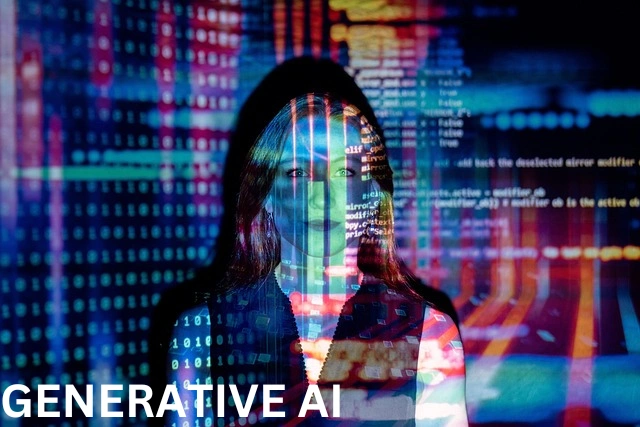TECHNOLOGY: AI AND GENERATIVE AI

THE IMPACT OF AI AND GENERATIVE AI ON COMPANIES AND TECHNOLOGY DOMAINS IN 2025: REVOLUTIONIZING ROBOTICS, SUPPLY CHAINS, AND ENERGY
The rapid development of Artificial Intelligence (AI) and generative AI technologies is poised to dramatically reshape multiple industries by 2025. Companies across various sectors will continue to leverage AI to streamline operations, improve customer experiences, and enable more efficient decision-making. This transformation is not limited to the traditional realm of AI applications like automation or machine learning. The rise of generative AI—systems capable of producing new content, models, and solutions—is opening new possibilities in robotics, supply chains, energy management, and beyond. As we approach 2025, AI’s integration into these fields is expected to bring profound changes, fostering innovations that were previously unimaginable.
In this article, we will explore how AI, and particularly generative AI, is expected to impact key technology domains in the coming years, including robotics, supply chains, and energy management. From automated production lines in manufacturing to smarter energy grids that adapt to real-time demands, the advancements of AI will drive efficiency, sustainability, and growth in a variety of sectors. We will also examine the challenges and ethical considerations surrounding the widespread adoption of these technologies.

AI and Generative AI: A Brief Overview
Before delving into the specific impact of AI and generative AI on various domains, it’s important to clarify the distinction between AI in general and generative AI.
Artificial Intelligence (AI) refers to the development of computer systems that can perform tasks typically requiring human intelligence. These tasks include learning from data, recognizing patterns, making decisions, and solving problems. AI systems use various techniques, such as machine learning (ML), natural language processing (NLP), and computer vision, to emulate human cognitive functions.
Generative AI, on the other hand, is a subset of AI that focuses on creating new content or solutions. Unlike traditional AI systems that focus on analyzing data, generative AI models are designed to produce entirely new outputs based on existing data. These outputs can range from images, music, and text to more complex solutions like 3D models or optimized business strategies. Popular examples of generative AI include OpenAI’s GPT-3, which can generate human-like text, and DALL-E, which creates images from textual descriptions.
As AI evolves, generative AI is expected to play a central role in transforming how businesses and industries operate. Let’s now explore how these technologies are expected to impact key sectors such as robotics, supply chains, and energy management.
Robotics: Automating Complex Tasks and Enhancing Human-Machine Collaboration
Robotics has been an area of rapid development over the past few decades. From manufacturing and assembly lines to healthcare and logistics, robots have already begun to replace or augment human labor in many sectors. However, the true potential of robotics is only now beginning to be realized, largely due to advances in AI and generative AI.
AI and Robotics in Manufacturing
By 2025, AI will enable robots to carry out much more complex and varied tasks than ever before. Traditional robots in manufacturing are typically limited to repetitive, pre-programmed actions, such as assembling parts or packaging products. However, AI-powered robots will be capable of learning from their environment, adapting to new tasks, and working autonomously in dynamic settings.
Generative AI will play a crucial role in this transformation. For instance, generative design tools, powered by AI, will allow robots to design their own components or tools based on specific performance criteria. This capability will lead to faster prototyping and more efficient manufacturing processes. Robots will also be able to optimize their movements in real-time, reducing waste, improving speed, and enhancing safety on factory floors.
Moreover, robots will increasingly work alongside human workers in collaborative environments, also known as collaborative robots (cobots). These cobots will be able to interpret human gestures, voice commands, and intentions using advanced computer vision and NLP algorithms. This interaction will allow human workers to focus on higher-level tasks, while robots handle the more repetitive and physically demanding work.
Healthcare Robotics
In healthcare, robotics is expected to make significant strides by 2025, with AI-powered robotic systems assisting in surgeries, diagnostics, and patient care. Generative AI will aid in designing surgical tools and prosthetics tailored to individual patients’ needs. AI-driven robots will also help in analyzing medical data to make more accurate diagnoses and suggest personalized treatment plans.
One key example will be the use of robotic surgical systems, where AI can continuously analyze real-time data from medical instruments and sensors, adapting the robot’s actions to optimize the outcome. Generative AI will also help in creating personalized rehabilitation programs, designing custom prosthetics, and even generating predictive models that allow for better pre-surgical planning.
Supply Chains: AI-Driven Optimization and Resilience
The supply chain sector has long been a prime candidate for AI applications, particularly in areas like logistics, demand forecasting, and inventory management. However, the full potential of AI, particularly generative AI, has yet to be realized. In 2025, AI will drive major improvements in the efficiency, resilience, and sustainability of supply chains.
Predictive Analytics and Demand Forecasting
Generative AI will be used to optimize demand forecasting by analyzing large sets of historical data and generating predictive models. By accurately predicting customer demand, businesses will be able to adjust production schedules, reduce stockouts, and minimize excess inventory. These AI-powered solutions will enable more agile supply chains, reducing the need for costly inventory while ensuring that the right products are available at the right time.
In addition, AI will use real-time data—such as weather patterns, geopolitical developments, and social media trends—to predict disruptions in the supply chain. This will help companies respond proactively to events such as natural disasters, labor strikes, or shortages in raw materials. Generative AI will also be leveraged to design supply chain networks that are optimized for speed, cost, and resilience, ensuring minimal disruption even in times of uncertainty.
Autonomous Transportation and Delivery
AI and generative AI will enable the widespread use of autonomous vehicles and drones in logistics and delivery. By 2025, autonomous trucks, drones, and delivery robots are expected to become common in transporting goods between warehouses and customers. These AI-powered systems will be capable of real-time route optimization, ensuring that products are delivered quickly and efficiently while minimizing fuel consumption and emissions.
Generative AI will enhance these systems by allowing autonomous vehicles to design optimal delivery routes based on a variety of factors, including road conditions, traffic, and fuel efficiency. This capability will significantly reduce transportation costs while improving delivery speeds.
Supply Chain Sustainability
As sustainability becomes an increasingly important focus for businesses and governments, AI will play a key role in helping organizations reduce their environmental impact. AI-powered tools will optimize transportation routes to minimize fuel consumption and greenhouse gas emissions, while generative AI can design packaging solutions that are more efficient and use fewer resources.
In 2025, generative AI will help businesses rethink supply chain processes, encouraging the creation of circular supply chains where materials are recycled and reused, minimizing waste. AI will also enable businesses to track and report on sustainability metrics, ensuring that companies meet their environmental goals while improving their bottom line.
Energy: AI-Optimized Grids and Sustainable Energy Solutions
The energy sector is undergoing a significant transformation, driven by the need for more sustainable and efficient energy solutions. AI, and generative AI in particular, will play a key role in optimizing energy production, distribution, and consumption by 2025.
Smart Grids and Energy Distribution
AI-powered smart grids will become the backbone of energy distribution systems by 2025. These grids will use AI algorithms to predict demand, monitor energy usage, and manage the flow of electricity in real-time. By analyzing data from various sources, such as weather forecasts, energy consumption patterns, and sensor data, AI will ensure that energy is distributed efficiently across the grid, reducing waste and preventing blackouts.
Generative AI will be used to design new energy distribution systems that are optimized for sustainability and cost-effectiveness. These AI-generated designs will improve the efficiency of power plants, wind farms, and solar arrays, allowing them to produce more energy while minimizing costs and environmental impact.

Renewable Energy Integration
The shift towards renewable energy sources, such as solar and wind power, is a key aspect of the future energy landscape. However, renewable energy generation can be unpredictable, as it depends on weather conditions and other environmental factors. AI will be used to optimize the integration of renewable energy into the grid, ensuring that power is generated and distributed when and where it is needed.
Generative AI will help design new renewable energy systems, such as solar panels and wind turbines, that are more efficient and cost-effective. AI-driven systems will also predict energy demand and supply fluctuations, allowing for better storage solutions, such as battery systems, to ensure that renewable energy is available during periods of high demand or low production.
Energy Efficiency and Consumption Management
AI will play a significant role in helping consumers and businesses reduce their energy consumption. By analyzing data from smart meters, AI-powered systems will provide recommendations on how to optimize energy usage, reduce waste, and lower costs. Generative AI will also be used to design energy-efficient buildings, appliances, and industrial systems, making it easier for companies to achieve their sustainability targets.
Ethical Considerations and Challenges
While the potential benefits of AI and generative AI are enormous, their adoption also raises important ethical concerns and challenges. The increasing automation of jobs in fields like manufacturing, logistics, and healthcare may lead to job displacement, particularly for low-skilled workers. There is also the risk of bias in AI algorithms, which can lead to unfair outcomes or perpetuate existing inequalities.
Moreover, the widespread use of AI and robotics will require businesses and governments to ensure that ethical standards and regulations are in place to protect privacy, security, and human rights. As AI technologies continue to advance, collaboration between stakeholders will be essential to address these challenges and ensure that AI’s benefits are distributed equitably.

Conclusion: The Future of AI and Generative AI in 2025
By 2025, AI and generative AI will have a profound impact on industries ranging from robotics and supply chains to energy management. These technologies will drive efficiencies, improve sustainability, and enable businesses to innovate in ways that were previously unimaginable. However, as these technologies become more integrated into everyday operations, it will be important to consider the ethical implications and ensure that AI is deployed in a responsible and transparent manner.
For companies looking to stay competitive in this rapidly changing landscape, adopting AI and generative AI technologies will be crucial to their success. By embracing these innovations, organizations can not only improve their operations but also help shape a future that is more efficient, sustainable, and equitable.









